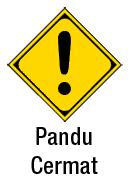Kuala Lumpur Structure Plan 2020
It's not that they don't know what to do:
401. LRT and commuter rail usage has been encouraging. However, optimal usage has still to be achieved due to:
405. Despite the improvements to the bus system and road infrastructure, bus utilisation is low, primarily as a consequence of route duplication, unreliable service frequency, overcrowding during peak hours and the poor condition of buses.
406. The existing main bus terminal is at Puduraya in the City Centre. The majority of inter city buses and coaches terminate there, thus adding to traffic congestion and consequently, longer journey times for passengers.
408. There is no shortage of taxis but availability is frequently a problem at peak periods and during bad weather.
416. About 52 percent of the total numbers of fatal and serious accidents in Kuala Lumpur involve motorcycles. Motorcycles are the major source of urban air and noise pollution. Noise emission from motorcycles in the City Centre exceeds permissible noise limits (Malaysia Environmental Quality Report 1996, DOE).
421. Because no requirement has been made in privatization agreements, major toll highways have been built without any specific provision for public transport or freight vehicles. The potential for maximising the utilisation of these highway routes for high-speed public transport connections to outlying areas has not been exploited.
422. The development of major roads in Kuala Lumpur has not always fully observed road classification requirements. In addition, some roads have assumed functions for which they were not originally designed such as residential roads that have become trunk roads due to ill-considered road connections. These anomalies have presented difficulties in the design and management of the overall road network.
426. Cycle ways have, for some time, been incorporated into new housing estates and recreational areas. Despite the relatively flat terrain of Kuala Lumpur, cycling as a convenient means of transport is under utilised partly due to local climatic conditions. There are also, however, some shortcomings in the existing cycle way network which contribute to the under utilisation of bicycles.
427. Opportunities exist for bicycle transport in providing connections to public transport services and short distance local travel. Other cities have utilised their roads, rail and open space corridors to create a comprehensive local area cycle way network.
431. To create an efficient and equitable city structure for Kuala Lumpur, CHKL aims to:
432. To enhance the city living environment, CHKL aims to:
433. If current trends continue, motorised trips by car in 2020 are expected to be almost double those of 1997. Increasing road capacity by constructing new roads and widening existing roads do not, in the long run, resolve the situation but simply postpone the problem until more roads need to be built. Most areas in the City, especially the City Centre, are now built up and land acquisition for road development is becoming increasingly difficult and expensive.
434. CHKL is, therefore, moving towards a Travel Demand Management strategy that aims to redirect movement patterns from private to public transport by integrating transport modes, extending and promoting public transport and discouraging the use of private transport. The public transport system in the City must be competitive, convenient, userfriendly and accessible to all income groups.
436. A principal objective of the transportation sector is the integration of land use with transportation and the development of a Transit Oriented Development Strategy. This strategy, which is detailed in Chapter 6: Land Use and Development Strategies, will promote intensified development along the rail network. Any planned extension to the rail network must, therefore, complement this policy by ensuring that rail stations serve designated urban centres.
438. Consistent with the government’s policy, emphasis will be on providing an integrated, flexible, wide ranging and efficient public transport system orientated towards passenger accessibility and convenience. Central to this approach is the integration of public transport modes with each other and with private transport so that, with streamlined inter-modal transfer facilities and integrated ticketing, passenger trips become as convenient and seamless as possible.

Figure 10.3 : Integrated rail based public transport system, 2000
440. The rail network is the most efficient means of providing high capacity rapid public transport. Medium and long-term plans for the introduction of different types of rail systems such as tram and the expansion of the rail network to outlying areas should be regularly examined in every 10 years for their feasibility.
441. The major growth areas in Kuala Lumpur are now well linked to the City Centre except those on the east-west axis. The feasibility of a new Damansara - Cheras LRT line linking growth areas in the east and west shall be investigated together with new rail links to serve district centres, comprehensive development areas and growth areas.
Kuala Lumpur Structure Plan 2020, by Dewan Bandaraya / City Hall
Saya sokong. But wait, is there a similar plan for Subang Jaya, Shah Alam, Klang, Petaling Jaya, Ampang Jaya, Gombak, Selayang, Kajang, Seremban dan lain-lain. The Klang Valley consists of more than just Kuala Lumpur. And we need a plan for the whole Klang Valley, not just for KL. What are the other Local Authorities doing?
But seriously, this 2003 plan could have been published in in the 1984. Who knows the same thing will be written in 2023?
I have said it many times, I don't really need to write much actually. Everything that needs to be done is already known. All the solutions are all waiting to be adopted. Plans have already been made.
Let's stop this curse!






0 Comments:
Post a Comment
<< Home